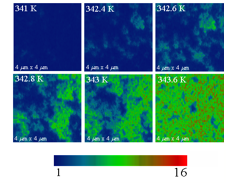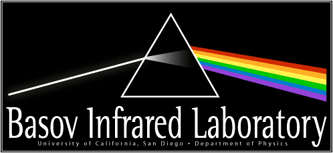| Infrared Nano-Optics of Quantum Materials | |||
|---|---|---|---|
|
|
Physics of Strongly Correlated Electron SystemsThe physics of materials with strong electronic correlations is remarkably rich and complex and cannot be understood within the conventional theories of metals and insulators. In correlated materials, charge, spin, orbital and lattice degrees of freedom result in competing interactions. These lead to phase transitions and the emergence of exotic phases including the pseudogap state in cuprates and manganites, high-temperature superconductivity, charge stripes in cuprates, even phase separation in some manganites and cuprates. Vanadium dioxide (VO2) is a canonical example of a transition metal oxide with correlated electrons. It undergoes a phase transition from the low temperature, monoclinic insulating phase to a high temperature, rutile metallic phase at Tc=340 K accompanied by a structural change. A controversial issue is whether the insulator-to-metal transition (IMT) is driven primarily by the structural change due to electron-phonon interactions leading to a Peierls insulator or by electron-electron interactions resulting in a Mott insulator. Our far-field infrared studies on VO2 and the related oxide V2O3 have revealed the importance of electronic correlations in these materials [1,2]. Recently, we performed scanning near-field infrared studies on VO2 in the IMT regime and discovered that the IMT regime is phase-separated into nanoscale metallic ‘puddles’ existing in the insulating host (see Figure 1). In combination with far-field infrared spectroscopy, the new results reveal a novel collective electronic state with divergent optical mass in the metallic puddles that is remarkably different from the macroscopic rutile metallic phase of VO2 [3]. The divergent optical mass suggests that electron-electron interactions drive the IMT in VO2 and it follows that the IMT is primarily a Mott transition.  Figure 1: 4 x 4 mm size images of the near-field scattering amplitude obtained by scattering scanning near-field infrared microscope (s-SNIM) operating at the infrared frequency w = 930 cm-1. These images are displayed for representative temperatures in the insulator-to-metal transition regime of VO2 to show percolation in progress with increasing temperature. The metallic regions (light blue, green and red colors) give higher scattering near-field amplitude compared to the insulating phase (dark blue color). The color bar represents the variation in the scattering amplitude (relative units). Electronic correlations in the iron pnictides Optical experiments directly probe the kinetic energy (K) of electrons in solids. Interactions of electrons with themselves and with phonons and spin fluctuations affect their motion and consequently their kinetic energy. We have investigated the parent compounds of the iron pnictide high-Tc superconductors LaFePO and BaFe2As2 with optical spectroscopy to determine the nature of electronic interactions in these materials. We find that the measured kinetic energy (Kexp) in the iron pnictides is substantially reduced compared to the band theory value (Kband) of nearly free electrons (Figure 2). We determine that this observation cannot be explained by spin fluctuations alone, and indicates the relevance of Coulomb correlations in these materials. Thus, we have established the precise nature of the interactions in the iron pnictides. This will lead to a better understanding of their correlated metallic state and the superconducting instability [4]. Fig. 1 : Ratio of the experimental kinetic energy and the kinetic energy from band theory Kexp/Kband for the iron pnictides and various other materials.
[1].
M. M. Qazilbash, K. S. Burch, D. Whisler, D. Shrekenhamer, B. G. Chae,
H. T. Kim, and D. N. Basov, Phys. Rev. B 74, 205118 (2006).
[2]. M. M. Qazilbash, A. A. Schafgans, K. S. Burch, S. J. Yun, B. G. Chae, B. J. Kim, H. T. Kim, and D. N. Basov, Phys. Rev. B 77, 115121 (2008). [3]. M. M. Qazilbash, M. Brehm, Byung-Gyu Chae, P.-C. Ho, G. O. Andreev, Bong-Jun Kim, Sun Jin Yun, A. V. Balatsky, M. B. Maple, F. Keilmann, Hyun-Tak Kim, and D. N. Basov, Science 318, 1750 (2007). [4]. M. M. Qazilbash et al., Nature Physics 5, 629 (2009). [5]. D. N. Basov and A.V. Chubukov, “Manifesto for higher Tc”, Nature-Physics 7, 272 (2011). [6]. D. N. Basov, Richard D. Averitt, Dirk van der Marel, Martin Dressel, and Kristjan Haule “Electrodynamics of correlated electron materials” Reviews of Modern Physics 83, 471 (2011). [7]. A. A. Schafgans, S. J. Moon, B. C. Pursley, A. D. LaForge, M. M. Qazilbash, A. S. Sefat, D. Mandrus, K. Haule, G. Kotliar, and D. N. Basov PRL 108, 147002 (2012). [7]. A. A. Schafgans, S. J. Moon, B. C. Pursley, A. D. LaForge, M. M. Qazilbash, A. S. Sefat, D. Mandrus, K. Haule, G. Kotliar, and D. N. Basov PRL 108, 147002 (2012). |
||
t |
|||
 |
|||